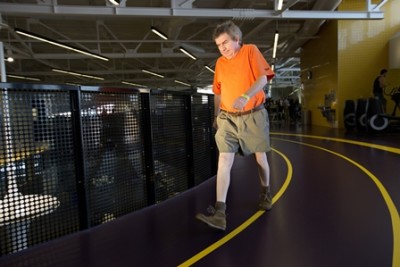
AHS-City partnership promotes lifelong health, eases transition from hospital
After two heart attacks and triple-bypass surgery, Doug Hunter was understandably anxious about how to exercise safely as he faced his own Goldilocks dilemma — how much is too much, too little … or just right?
“There’s a lot of anxiety when you come out of open-heart surgery,” says the 63-year-old city writer. “You wonder: ‘What can I do safely?’ It means a lot to be in a safe, secure environment where you can push, where you can try stuff.”
To his credit, Hunter is now turning his hospital-based cardiac rehabilitation into a lifelong exercise habit at his community recreation centre thanks to a new Alberta Health Services (AHS) pilot program that helps heart patients to shed workout anxiety and gain confidence during their recovery.
Thanks to a partnership between AHS and the City of Edmonton, patients who have experienced heart attacks and/or cardiac surgery can now enjoy medically supervised rehab that’s more comfortable, convenient and often closer to home in the Cardiac Rehabilitation Community Integration Program, currently available at Clareview Community Recreation Centre.
“Coming to a hospital-based program can be intimidating for patients and exercising, in general, can be intimidating for patients, especially after a cardiac event,” says Kara Penney, who oversees cardiac rehabilitation for the Mazankowski Alberta Heart Institute and the Northern Alberta Cardiac Rehabilitation Program (NACRP). “Our goal is to integrate patients into the community safely. Our full eight-week service is now available at Clareview.”
Josh Koehli, program manager with the City of Edmonton, says the city’s goal is to promote health and well-being through increased recreation opportunities.
“We understand participating in and sustaining physical activity is challenging for many, so we hope this partnership will benefit patients by providing a smoother transition from a medical setting to a recreational one,” he says.
Typically, Edmonton-area cardiac patients receive eight weeks of rehabilitation in the gyms at the Glenrose Rehabilitation Hospital or the at the Mazankowski Alberta Heart Institute. Exercising under the guidance of their case manager and an exercise specialist, patients can also access their other NACRP team members, such as an occupational therapist, pharmacist, social worker, dietitian and psychologist, as required.
Patients now have the option to take part or all of their rehab at Clareview, where they are met at the front door weekly by their case manager and exercise specialist who attend their workouts.
“We’re providing safe, monitored exercise and education sessions for low to moderate risk patients in a community facility,” says Penney. “This allows them to familiarize themselves with a local gym and perhaps even strike up friendships with members of the gym. This way, when they finish their rehab program, they’re more inclined to continue on their fitness journey.”
Should patients choose to buy a community membership, the city offers a 20 per cent discount, plus 15 per cent off for a support person or family member who wishes to join with them. “As well, rec centre parking is free, which is a huge bonus for most patients,” adds Penney.
In his case, Hunter moved his rehab from hospital to the Clareview rec centre to be closer to home.
“That’s part of the charm,” he says. “It’s only four minutes away. It means a lot to be in a safe, secure environment. My exercise specialist details how much time I should spend on each machine and at what intensity. Over time, he’s helped me to do more.”

More patients like Hunter are also taking advantage of ‘bridging’ — moving hospital-based rehab to the community rec centre midway through recovery.
“There may be some patients who don’t feel comfortable exercising in the community when they embark on their eight-week program,” says Penney, “but by week four or five, they’re starting to see the benefits of integrating themselves into the community. So we bridge them.
“They attend their last few sessions with us in the community. It’s still monitored, and they have all of our clinical resources as they build new relationships and a workout routine in the rec centre.
“I think, in the future as our cardiac patient population increases with our aging population, it makes sense for us to be more embedded in the community,” adds Penney, “and to use our hospital-based exercise settings for our high-risk, acutely ill cardiac patients.”
After rehab, the Northern Alberta Cardiac Rehabilitation Program does followups with its patients at three, five and six months. Out of 200 referrals a month, the Mazankowski and NACRP admit about 150 patients to its rehab programs. To date, 40 patients have opted for the new community-based pilot program, which has just been renewed for a second year, says Penney.
Annett Kamenz, Supervisor for Recreation & Physical Activity Experiences with the City of Edmonton: “I’m proud that we’re part of this and that we’re helping patients to achieve their health goals as they integrate back into the community and stay active.”
Hunter, who just bought himself a discounted, one-year membership, adds: “This program is absolutely tailor-made for someone like me, who’s never been a gym rat. To have it close and available and with the same therapist I had at the hospital is absolutely wonderful.
“I’ve been on my own now for more than a month, going three times a week — and now I’m creating my own benchmarks.”

